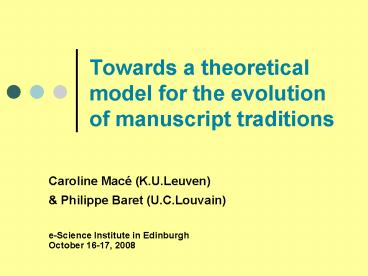Towards a theoretical model for the evolution of manuscript traditions - PowerPoint PPT Presentation
1 / 39
Title:
Towards a theoretical model for the evolution of manuscript traditions
Description:
Towards a theoretical model for the evolution of manuscript ... Too many bifurcating trees (bifid stemmata) = unrealistic. Cerquiglini, 'Eloge de la variante' ... – PowerPoint PPT presentation
Number of Views:21
Avg rating:3.0/5.0
Title: Towards a theoretical model for the evolution of manuscript traditions
1
Towards a theoretical model for the evolution of
manuscript traditions
- Caroline Macé (K.U.Leuven)
- Philippe Baret (U.C.Louvain)
- e-Science Institute in EdinburghOctober 16-17,
2008
2
- Introduction the genealogical method
- Stemmatics and phylogenetics
- Beyond the results
- Convergences and divergences
- Cladistics vs. Phylogenetics
- Conclusion is there a future for the
genealogical method?
3
1. Genealogical Method
4
(No Transcript)
5
Searching for a method
- Textus receptus
- Best manuscript
- Best text eclectism, emendatio, divinatio
6
Genealogical method stemma
P. Van Deun (ed.), Maximus Confessor, Liber
Asceticus, Turnhout, 2000.
7
Result critical text and apparatus
C. Steel, C. Macé, P. dHoine (eds.), Proclus, In
Parmenidem, Oxford, 2007.
8
Criticizing the genealogical method
- Bédier
- Too many equally possible stemmata misleading
- Too many bifurcating trees (bifid stemmata)
unrealistic - Cerquiglini, Eloge de la variante
- Living texts vs. dead (a-historical) editions
9
The origin of the genealogical method
C.G. Zumpt (ed.), Cicero, Verrine Orations, 1831,
p. xxxviii (footnote)
10
The origin of the genealogical method
Gaston Paris (1839-1903)
Karl Lachmann (1793-1851)
11
Schleichers tree (1853)
- Winfred P. Lehmann , A Reader in Nineteenth
Century Historical Indo-European Linguistics - http//www.utexas.edu/cola/centers/lrc/books/read0
8.html
12
Charles Darwin (1809-1882)
Charles Darwin, Notebook B, 1837, p.
36 (http//darwin-online.org.uk/manuscripts.html)
13
The origin of species, 1859
- All the foregoing rules and aids and difficulties
in classification are explained, if I do not
greatly deceive myself, on the view that the
natural system is founded on descent with
modification that the characters which
naturalists consider as showing true affinity
between any two or more species, are those which
have been inherited from a common parent, and, in
so far, all true classification is genealogical
that community of descent is the hidden bond
which naturalists have been unconsciously
seeking, and not some unknown plan of creation,
or the enunciation of general propositions, and
the mere putting together and separating objects
more or less alike. (p. 420)
14
2. Stemmatics and phylogenetics
15
(No Transcript)
16
Two experiments
- Overabundant manuscript tradition of a Patristic
text - Gregory the Theologian (ca. 330- ca. 390)
- 45 homilies written around 380
- 1200 manuscripts copied between 850 and 1550
- ancient translations made between 400 and 650
- Artificial tradition
- S. Dagerman, Notre besoin de consolation est
impossible à rassasier (transl. from Swedish by
P. Bouquet) - 12 copies
- No external evidences, no relative dating of the
witnesses
17
Two experiments
- Gregory the Theologian, Homily 27
- 2000 words
- 130 witnesses
- 126 manuscripts (850 - 1550)
- 4 translations (400 - 650)
- Editio Princeps Aldina (1516)
- Collation
- 556 variant locations
- 691 variant readings
- Artificial tradition
- 1015 words
- 12 copies
- Collation
- 119 variant location
- up to 4 variants on each variant location
18
Two experiments
- Of Gregory was there a 18th cent. edition, but no
complete history of the text - The stemma of the artificial tradition had been
documented
19
Gregory the Theologian Neighbor Joining
20
Gregory the Theologian Parsimony Consensus
Unrooted Tree
B
A
21
Gregory the Theologian validation
22
Gregory the Theologian Parsimony Consensus
Rooted Tree
B
A Sicily
A
Syria
sub-B
B
23
Artificial tradition NeighborJoinining
24
Artificial tradition Parsimony Consensus Tree
25
Artificial tradition philology
26
Artificial tradition difficult cases
- T1/T2 cime
- A scime
- J scime C (sc/n)ime U cîme
- M nime S cime copies
27
Artificial tradition exemplar shift
NJ - 1st third of the file
NJ - 3rd third of the file
28
Artificial tradition internalisation of nodes
?
?
?
29
3. Beyond the results
30
Convergences and divergences
- Convergences
- Same methodological principle shared innovations
- Similar difficulties in applying this principle
cladistics vs. other methods in phylogenetics - Similar problems in delimiting, describing and
weighting characters
- Divergences
- Dichotomy vs. polytomy
- Surviving intermediates
31
Phylogenetics
M. Holder - P.O. Lewis, Nature 2003, Vol. 4
(April), p. 276 www.nature.com/reviews/genetics
32
Phenetics vs. cladistics
- PHENETICS
- similarities
- unrooted tree, which can be rooted on the basis
of external evidences
- CLADISTICS
- characters states
- only derived states are informative, as we dont
know when an ancestral state was acquired
Phylogenetic character (Vogt) position whithin
an organism where the mutation occurs, and its
corresponding transformation. () a phylogenetic
character is always a phylogenetic hypothesis.
33
Recoding the information
34
Recoding the information
35
Cladistic approach Tree 1
Tree 2 Differences
36
Cladistic approach Tree 1
Neighbour Joining
37
Cladistic approach Tree 1
38
4. Conclusion is there a future for the
genealogical method?
39
Towards a theoretical model for the evolution of
manuscript traditions































